How to Build Print on Demand Marketplace

Marina Vasilyeva, Client Manager in Multi-Programming Solutions • 9 min read
Many entrepreneurs begin their POD business by developing an effective strategy. They determine achievable goals and discover the potential for further growth. Dropshipping, purchasing printing inventory, renting warehouses, and providing multichannel sales - this is not even the complete list of possible solutions for future scaling. And this article, we dedicate to building an online marketplace as one of the excellent opportunities for companies to thrive and get competitive advantages. But first, let’s see some vital numbers that predict further POD industry boosting.
Table of Contents
Fresh print on demand business stats for 2023
How to create a print on demand store?
How print on demand marketplace works?
How to create a unique selling proposition
Fresh print on demand business stats for 2023
The global POD market doesn’t give up positions and promises to gain 26.1% CAGR till 2023 reaching $39.4 billion in share. The apparel segment makes up 39.6% of it, being the most popular direction for POD business development. The other popular stuff includes home decor, drinkware, and accessories.
The latest print on demand marketplace statistics testifies that increased sales of customized goods are broadly caused by lowering operational costs caused by the automated software implementation. Optimization apps allowed POD sellers to provide order and inventory management faster and more accurately, saving resources and increasing overall efficiency.
The entertainment industry significantly impacts the printing market, driving demands on products with popular movie or cartoon characters. Modern customers may prefer t-shirts with popular printed slogans to a picturesque image.
Anyway, trends change, and successful entrepreneurs should adapt to current customers' desires more flexibly. But the necessity to build a robust online presence is constant because around 70% of the US and more than 27% of the global inhabitants buy online. And thus, we smoothly move to the next chapter, which describes how to build a digital shop.
How to create a print on demand store?
Many startupers worry that creating an online store on Shopify or another platform for selling customized products is a long and complex task requiring special skills. But we can ensure it’s simpler than it seems at first glance, especially when you have detailed instructions on hand. So we provide you with some tips on how to set up a print on demand store and conquer the e-commerce market.
Start to explore the possibilities with a free trial
All the user-friendly platforms allow customers to examine features for managing an online shop within several days for free. And Shopify is not an exception. You may visit an official page and launch a trial. As Shopify store building process requires entering a digital shop name, it will become a part of an URL. It may also be challenging to pick up a unique one. The system will notify you with an error message if your shop name already exists on the platform. Then you need to try your luck with another one.
After entering all the required information, press “Create an online store,” and you’ll get your personal selling profile.
Add a print on demand supplier
If you want to follow the dropshipping business model, find a reliable printer that will make customized stuff for you, pack it and send it to the final customer. At that time, you will focus efforts on how to bring customers to your print on demand store.
To streamline creating your listings and establishing communication with the vendor, you should connect your Shopify store with the printers’ application. For this purpose
- go to Shopify App Store and search POD apps
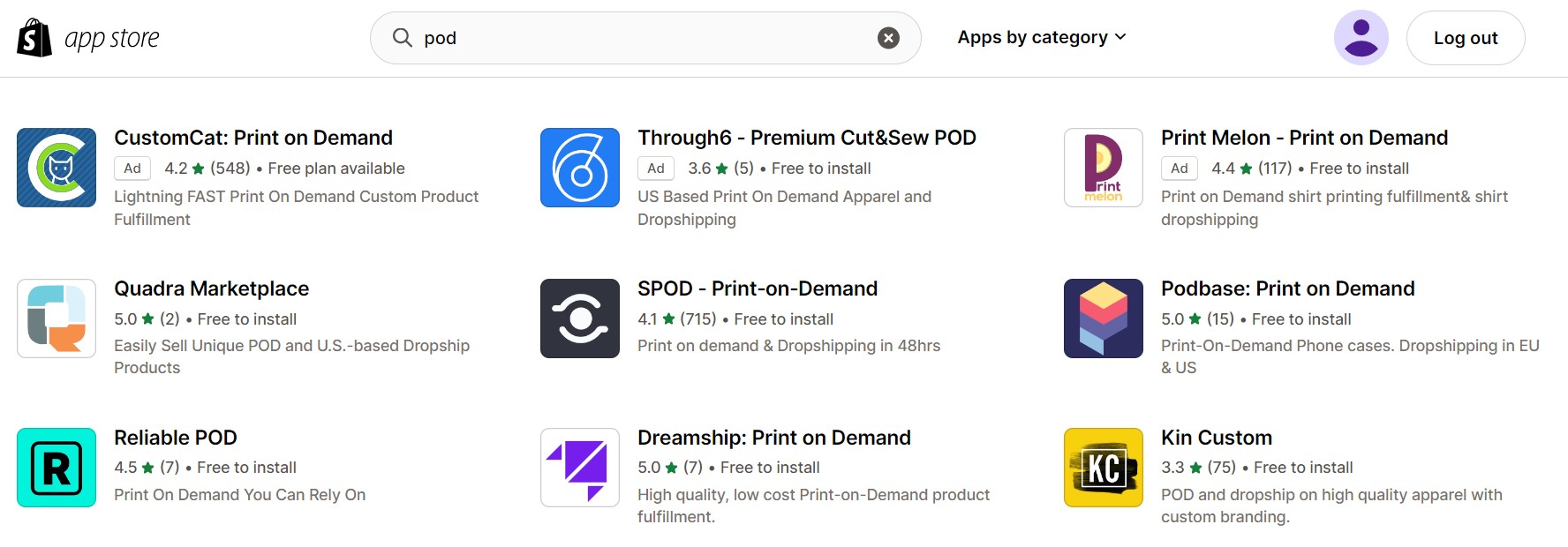
- select favorite app, then press “Add app”
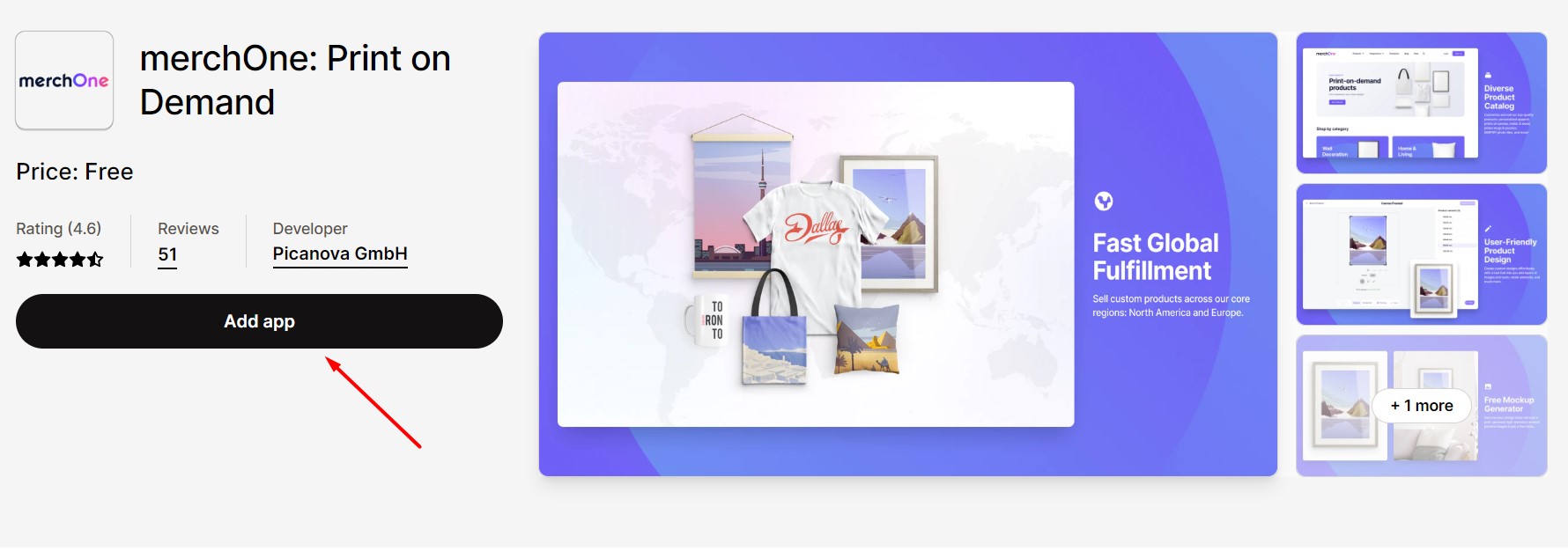
- then press “Install app”
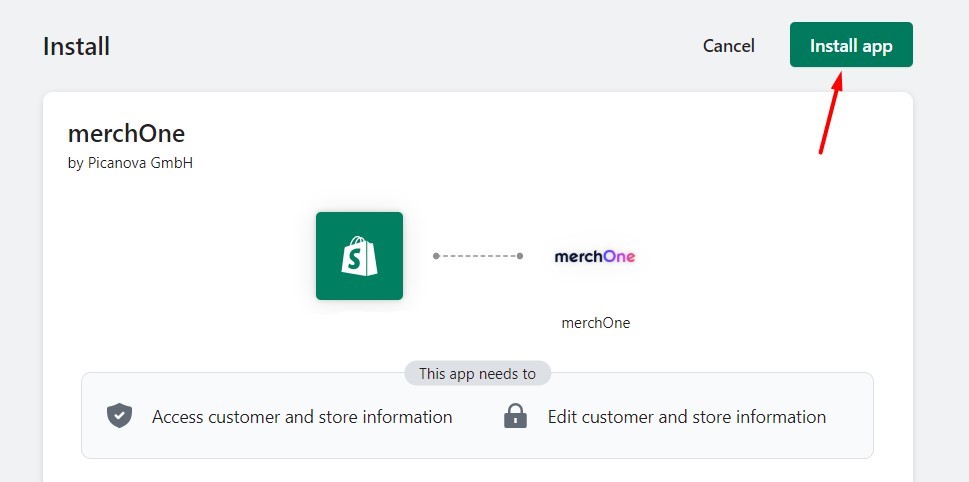
Create listings
At this step, you can integrate product assortment from your supplier’s app. We'll show you how to create products based on our Podza application that print companies use for themselves.
- First you need to go to Shopify Apps and select the installed supplier’s app. Find products that the supplier allows you to import into the store.
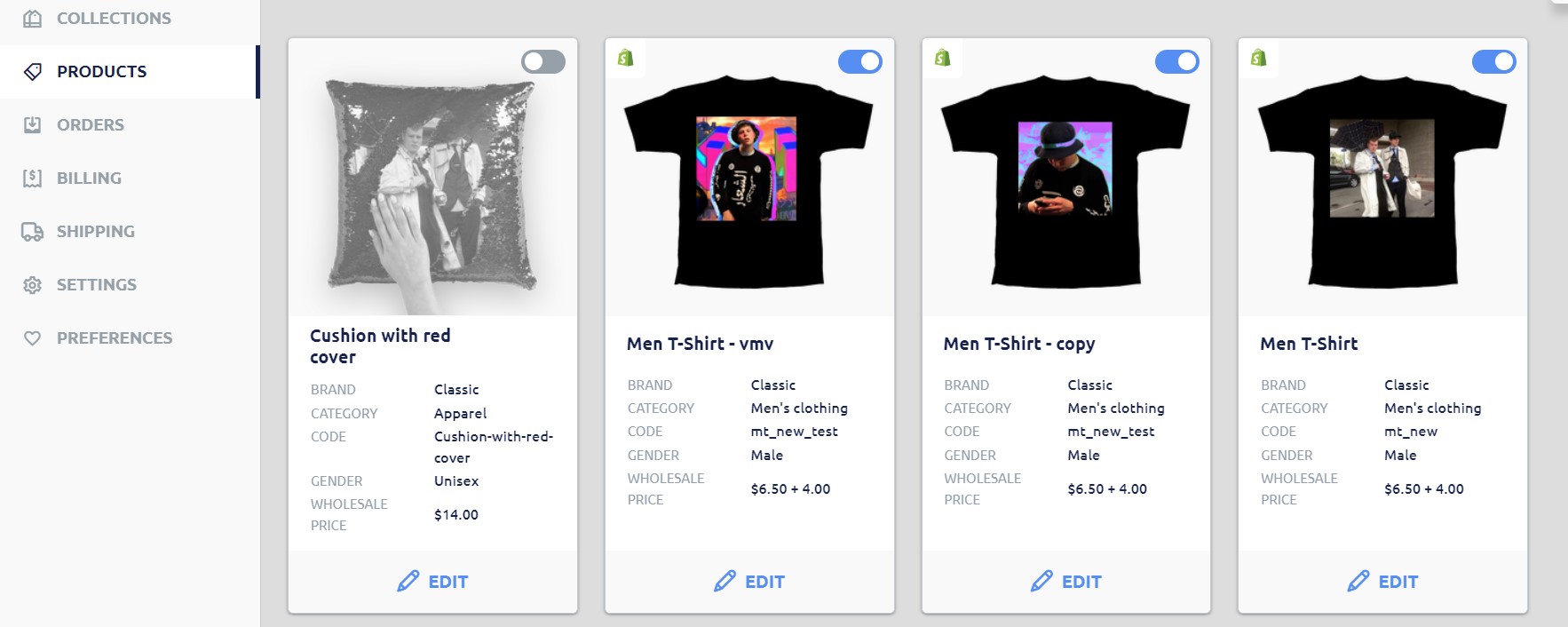
- For each product you need to create your own unique design. Earlier, we talked about how Freepik can help you create a cool design for your POD product. You go to the product that you want to add to your Shopify store and customize it by adding a unique image.

- Then you’ll be able to add colors, product sizes, titles, descriptions, tags, item prices and shipping information. Test the previews, save and publish products.

- You will see new products in your Shopify selling account.
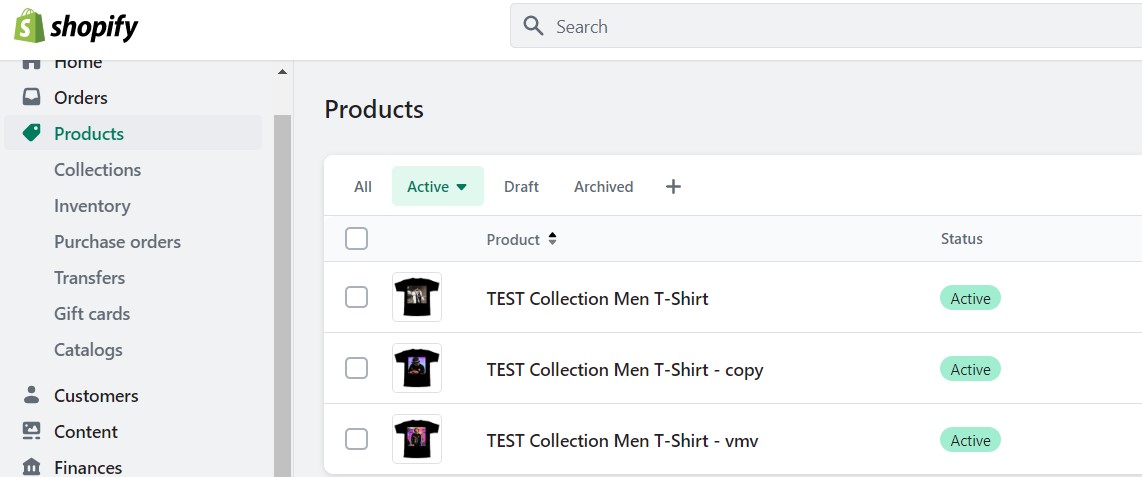
Make an eye-catching website design
There is an approved method of how to make a print on demand store stand out from the crowd. Use various themes to customize your store interface - most of them are free of charge. Also, you may examine paid options to integrate a one-of-a-kind design. Edit fonts, text, and images, and publish a theme, when you will get a satisfying result. Catch a useful article from us on how to make a cool design for your Shopify store.
Set up payment options
Your print on demand store business is only possible with safe financial transactions. Owners of the Shopify account are eligible for a dedicated payment system to accept clients' money for purchased products and send them to a supplier for order fulfillment. You can add a Shopify payment provider in profile Settings - Payments.
Open the store
During the trial period, clients can’t buy items from your store. This is when you only learn how to manage a webpage and customize it to your liking. You should choose a suitable subscription plan in Settings → Accounts → Compare plans to launch an online shop. Then remove a password, which protects the tested shop from clients’ orders in Preferences. That’s all, and now you can advertise your print on demand store and wait for your first buyers.
Now, when you learn how to establish a dropshipping POD business without stocking any inventory, let’s get familiar with the next amazing method of generating passive income. Except for retailing goods by yourself, you can build a thriving environment for other entrepreneurs and help them succeed too. Let’s learn it in more detail.
How print on demand marketplace works?
You’ve definitely heard about centralized platforms, like Amazon or eBay, allowing vendors to build their selling profiles and use the vast customer base. Around 63% of global digital purchases are made via marketplaces. And almost 85% of Americans confess they search through online listings on a daily basis.
With such a whopping popularity among online customers, many entrepreneurs are searching for possible ways to create an online marketplace like Amazon and gain more profit than running a digital shop. And here, a combination of a digital selling platform and a printing business can give you vast opportunities for gaining more revenue and scaling your e-commerce enterprise.
How To Sell Custom T-Shirts On Amazon
There are several possible ways you can earn additional profit and quickly pay back your investments in the development of the marketplace. But first, let’s figure out how it actually works.
When you have a Shopify digital store launched and running, you can invite other vendors to set up their selling accounts and showcase stuff or retail yours’. You build a system that allows other businesses to create branded digital stores and connects suppliers, artists, and printers. All you need to do is install print on demand marketplace software following simple instructions. The same operations can be done for WooCommerce shop owners who want to widen their business and create new opportunities for business growth.
Within the chosen app, you’ll be able to add multiple participants who can manage their orders, customers, and payment operations. Vendors can either upload their own product catalog or use your inventory in their listings. In the latter case, you’ll receive fees if the item is sold.
You can provide two methods of monetization for your print on demand marketplace. Firstly you may take fees for every listing merchants add to their selling profile. It is an excellent money-making model for those platform owners with a broad customer base. The only challenge in this scheme can be pricing. Merchants can simply leave you if they are too high. But on the other hand, with small fees, you risk having a low revenue. In this case, it is recommended to provide another charging option.
The second method is called commission based. Here you receive fees from the platform customers for every transaction. The scheme can be applied to vendors or end customers. You can also take money from both of them. But in this case, your offerings should bring undeniable value to interest users in cooperation with you. We’ll figure out how to create an online marketplace like eBay that will attract thousand of merchants and their target audience.
Beginner's Guide on Selling Print on Demand Clothing on eBay
How to create a unique selling proposition?
Within a highly competitive environment, it is absolutely essential for e-commerce entrepreneurs to develop distinct offerings which will highlight their digital platform among rivals and engage the target audience.
To build the best print on demand marketplace, you should think of a unique selling proposition (USP) that can bring advantages to your business:
- differentiate you from thousands of competitors;
- give clients overwhelming information about why they should choose your service;
- save your business from plagiarism;
- create a stable picture of your brand in customers’ minds.
Let’s dive deep into details and determine basic tips on how to build a successful marketplace.
Niche
It may be quite challenging to operate in different niches and be oriented on various customer types that differ by demands and behavioral characteristics. You risk lacking in the quality of service and losing vital details. Instead, if you focus on one direction you’re passionate about, it will be easier to succeed. For example, depending on your interest, you can dedicate an online marketplace platform for print on demand to sports, kids, pets, or other themes. You can learn more about how to define your niche here.
Products
You should think of a product range that will attract clients from your chosen niche to register an account on your platform and add your stuff to their stores. Some popular items that can be customized include cloth, home decor, jewelry, wall art, gifts, and others. Eco-friendly goods with one-of-a-kind designs are the ones you should pay attention to while building a POD marketplace website from scratch.
Top Print-on-Demand Product Ideas
Price
Prices for trading and listing on your platform should be calculated wisely so that you can gain stable profit and not speculate on users. If you charge commissions from vendors and their customers, you should ensure your goods are worth it.
How To Price Print-On-Demand Products
Benefits
Figure out what advantages other sellers or customers can receive from your marketplace. Describe what pain point your service or product range can solve and showcase them in your marketing campaigns on social media or other channels. You can describe the benefits of your UPS in the bio of the e-commerce platform or mirror them in promotional banners.
Experience
Ensure that you can provide a better customer experience than your rivals do. You should perform convenience on every stage of interacting with your POD marketplace, from easy onboarding and secure payments to 24/7 automated chatbot or free delivery.
Hearing
You should provide possibilities for customers to leave feedback about the level of your service and propositions for improving it. You can do it via special forms for customers' comments or dedicated social media profiles. Keep in mind that your clients are the reason why your business exists. So your UPS must respond to their needs, even in rapidly changing conditions.
How to deal with negative feedback if you develop a print on demand business?
FAQ
How much does it cost to build an online marketplace?
Prices can significantly differ depending on your business goals. If you have a tight budget, you may use ready-made (Magento) or SaaS solutions (Sharetribe). But if you have a large budget and want to become a one-of-a-kind player on the market, you should search for expert developers who know how to build a custom marketplace app from scratch.
How to promote my centralized selling platform?
Join internet communities like LinkedIn or Facebook, participate in dedicated discussions and popularize your brand. Provide e-mail marketing. Use multiple channels for advertising, including social media.
Who is responsible for delivery?
If the marketplace owner has no inventory and warehouses, sellers are responsible for delivering goods to the end customer. They can suggest various carrier services and special offerings, like discounts or free transportation but include costs in the products price. That's how a marketplace works with shipping.
Conclusion
With this guide on how to create a marketplace, we hope you’ve become more confident about the potential of the print on demand business development. Building a centralized platform allows one to set up multiple branded stores for individual vendors and manage its work from a single administration center. You may only control the marketplace work and receive charges for your services or offer your customized POD stuff for retailing as well.
The main challenge you may face is the necessity to propose an outstanding UPS, which redirects traffic from the competitors to your e-commerce platform. But with a close focus on excellent customer experience and high-quality personalized stuff, you’ll overcome this issue.


 REQUEST A FREE DEMO
REQUEST A FREE DEMO